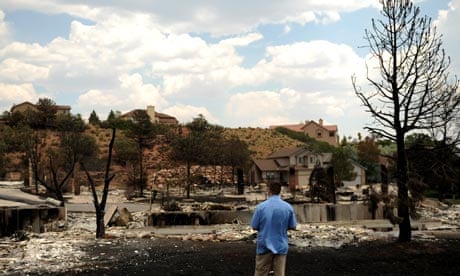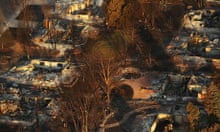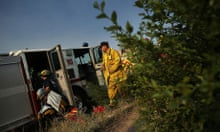The gated community of Cedar Heights would fit many people's definition of gracious living; capacious homes with cathedral ceilings, four-car garages and wrap-around decks, all artfully spaced so as not to intrude on the neighbours' panoramic mountain view.
It could have easily been destroyed in Colorado's devastating wildfires.
A media tour showed how close the enclave came to disaster. A ridge beginning just above the main road was charred black. The fire that raced across the canyon incinerated scrub, dried leaves on upper branches to a crisp, and in some places leaving an ankle-deep layer of ash.
But not a single home was touched by the fire – unlike the Mountain Shadows neighbourhood, where two people were killed and nearly 350 homes were destroyed – even though fire officials saw Cedar Heights as the most threatened neighbourhood when the fire started a week ago.
Officials said the development's survival is a testament to the dedication of the 1,100 crew fighting the fires. But it's also a story about the unpredictability of living on the edges of a fire-prone wildland area.
"One main reason it didn't get destroyed like Mountain Shadows? When the fire came up here it didn't have 65mph hour winds behind it," said Greg Heule, a spokesman for the fire effort.
"We had some luck," said Rick Schmidt of the Colorado Springs fire department:
Cedar Heights, according to the community website, offers homes at 6,500-8,000ft in a "forest-wild" community.
It was the first neighbourhood evacuated when the Waldo Canyon fire started last week. Residents were allowed to return on Friday night.
As soon as sparks from the wildfire began shooting out in the direction of Cedar Heights, fire tankers roared past the gate house and up the winding road, dousing the ridge with water.
Firefighters used bulldozers to drive a wide swathe through the pines as part of a strategy to create a physical barrier between the neighbourhood and the fire in adjacent canyons.
Ground crews, moving on foot, used axes to carve out more defensive lines through the trees.
Air Force units, operating from hulking C-130s, dropped flame retardant as an additional line of defence, staining the banks of a dirt road bright orange.
Their mission was made a little easier because of earlier preparations, Schmidt said. Residents were careful about clearing brush from around their homes.
Otherwise, fighting fire in a steep and densely forested canyon is a nightmare.
"This is a very steep area and there is a lot of fuel out there in the forest," Schmidt said.
Fire crews were still at it on Friday afternoon, walking carefully through the scorched areas, crouching now and then to feel the ground or tree stumps for live embers.
The effort paid off. Apart from the destruction in Mountain Shadows, most of the homes in Colorado Springs' danger zone made it through the fire.
Some 81% of homes in the evacuated areas were intact, the fire chief, Rich Brown, said.
The survival rate was due to the enormous effort by firefighters, he said. In some instances, crews raced around houses turning on sprinkler systems to stop the flames spreading. They hacked off wooden decks that were beginning to smoulder.
"It looked like a volcano you see on National Geographic, just building up," said Master Sergeant Jeff Flight, who worked on the aerial fire effort. "We just sat there in disbelief watching."
But for all those efforts, the argument could also be made that developments like Cedar Heights should never had been built in the first place.
Colorado has led the rest of the country in building up to the edges of public forests, placing high-end housing developments, like Cedar Heights, in areas thick with pine on rugged terrain.
Those new developments are exposed to greater risk, with the rise in wildfires because of climate change, drought, and the land management practices in the past.
Conservationists also argue protecting such new upscale developments impose an unfair budget on government fire protection budgets.
Now as Colorado Springs emerges from this wildfire, city officials acknowledge it may be time to rethink the pattern of development.
"We want to change something in that equation so that we don't end up with the same thing that we have now," said Steve Cox, an adviser to the city's mayor.





